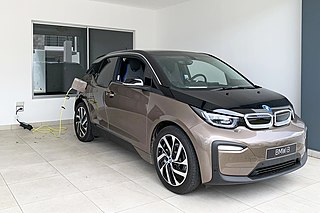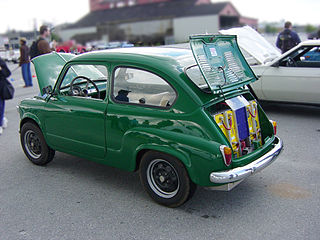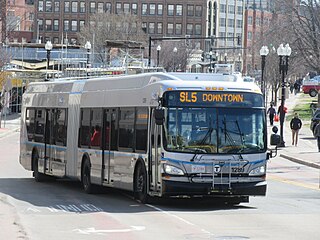
The Hyundai Motor Company, often referred to as Hyundai Motors, and commonly known as Hyundai, is a South Korean multinational automotive manufacturer headquartered in Seoul, South Korea, which was founded in 1967. Currently, the company owns 33.88 percent of Kia Corporation, and fully owns two marques including its luxury cars subsidiary, Genesis, and their electric vehicle brand Ioniq. The three brands altogether make up the Hyundai Motor Group.

An electric vehicle (EV) is a vehicle that uses one or more electric motors for propulsion. The vehicle can be powered by a collector system, with electricity from extravehicular sources, or can be powered autonomously by a battery or by converting fuel to electricity using a generator or fuel cells. EVs include road and rail vehicles, electric boats and underwater vessels, electric aircraft and electric spacecraft.

The Grumman Long Life Vehicle (LLV) is an American light transport truck model designed as a mail truck for the United States Postal Service, which has been its primary user since it first entered service in 1986, 38 years ago. It was also used by Canada Post. The LLV uses a chassis built by GM based on the S-10 with an aluminum body built by Grumman.

The Hyundai Tucson is a compact crossover SUV produced by the South Korean manufacturer Hyundai. It is named after the city of Tucson, Arizona. It was originally known as the Hyundai JM when it was introduced in Japan in 2004.

The Hyundai Elantra, also known as the Hyundai Avante, is a compact car produced by the South Korean manufacturer Hyundai since 1990. The Elantra was initially marketed as the Lantra in Australia and some European markets. In Australia, this was due to the similarly named Mitsubishi Magna Elante model; similarly, in other markets, the name Avante is not used due to its similarity with Audi's "Avant" designation, which is used for their line-up of station wagons. The name was standardized as "Elantra" worldwide in 2001.

In automobile engineering, electric vehicle conversion is the replacement of a car's combustion engine and connected components with an electric motor and batteries, to create a battery electric vehicle (BEV).
Hybrid vehicle drivetrains transmit power to the driving wheels for hybrid vehicles. A hybrid vehicle has multiple forms of motive power.

A hybrid electric vehicle (HEV) is a type of hybrid vehicle that combines a conventional internal combustion engine (ICE) system with an electric propulsion system. The presence of the electric powertrain is intended to achieve either better fuel economy than a conventional vehicle or better performance. There is a variety of HEV types and the degree to which each functions as an electric vehicle (EV) also varies. The most common form of HEV is the hybrid electric car, although hybrid electric trucks, buses, boats, and aircraft also exist.

ZAP was an American company that specialized in electric vehicles of various types, such as cars, motorcycles, bicycles, scooters, watercraft, hovercraft, ATVs and commercial vehicles. Its name was an acronym for Zero Air Pollution. It was based in Santa Rosa, California, but it is no longer active. The last record of the company in the California Secretary of State business entity database shows that its agent for service of process resigned on October 26, 2016.
Solectria Corporation was responsible for the design, engineering, and manufacturing of energy management components for industrial applications, including electric vehicles, parallel hybrid drivetrains, and power generation applications. It was founded in 1989 and based in Woburn, Massachusetts. In December 2004, Solectria was acquired by Azure Dynamics.

The Hyundai Blue-Will is a plug-in petrol-electric hybrid concept compact car designed by the South Korean car manufacturer Hyundai Motor Company. The vehicle was debuted at the 2009 Seoul Motor Show in South Korea.

A drivetrain or transmission system, is the group of components that deliver mechanical power from the prime mover to the driven components. In automotive engineering, the drivetrain is the components of a motor vehicle that deliver power to the drive wheels. This excludes the engine or motor that generates the power. In marine applications, the drive shaft will drive a propeller, thruster, or waterjet rather than a drive axle, while the actual engine might be similar to an automotive engine. Other machinery, equipment and vehicles may also use a drivetrain to deliver power from the engine(s) to the driven components.

The Hyundai ix35 FCEV or Tucson FCEV is a hydrogen fuel cell electric vehicle developed by Hyundai. The model is a left-hand drive only conversion to the SUV platform it is based on and was the first of its type to be mass-produced and sold commercially in the world. Different versions are known, the previous version was based on the Hyundai Tucson FCEV, and the upcoming model is based on the current ix35 FCEV. The first generation was introduced in 2001, with the Hyundai Santa Fe FCEV, and had a range of 100 miles (160 km), with a top speed of 78 mph (126 km/h).

The Kia Niro is a compact crossover SUV (C-segment) manufactured by Kia since 2016. It is an electrification-focused vehicle, offering three versions: hybrid, plug-in hybrid and battery electric variants.

The Hyundai Ioniq is a compact five-door liftback manufactured and marketed by Hyundai. The nameplate Ioniq is a portmanteau of ion and unique. It is marketed as the first Hyundai automobile to be offered without a standard internal combustion engine, but rather sold in hybrid, plug-in hybrid, and all-electric variants.
Paice is a Baltimore headquartered hybrid technology company. The company currently holds numerous patents in this field of technology. The company develops transitory technology for gas-driven and electricity-driven vehicles. Paice is currently involved in numerous patent conflicts with other larger companies of which an outcome has not yet been reached.

The Hyundai Kona is a subcompact crossover SUV produced by the South Korean manufacturer Hyundai. The first-generation Kona debuted in June 2017 and the production version was revealed later that year. It is positioned between the Venue or Bayon and the Tucson in Hyundai crossover SUV line-up. The battery electric version called the Kona Electric was first launched in South Korea during the first half of 2018 and rolled out gradually worldwide afterwards.

The Hyundai Vision FK is a concept car that uses a plug-in hybrid drivetrain with both a large traction battery and a hydrogen fuel cell; the concept vehicle was developed by Hyundai and Rimac Automobili. The mid-motor, rear-wheel-drive sports coupe was unveiled at the Hydrogen Wave Forum in September 2021, an event organized by Hyundai to outline its plans to popularize hydrogen vehicles by 2040 for "Everyone, Everything and Everywhere". Power is delivered through two electric traction motors, both on the rear axle. The Vision FK can be plugged in to recharge its traction battery, which has more than 60 kW-hr of energy storage capacity, and the onboard fuel cell affords it a range greater than 600 km (370 mi).
An electromod is a vehicle that has been restored and modified by converting its drivetrain to operate as an electric vehicle (EV). The term is a portmanteau of electrification and restomod, itself a portmanteau of restoration and modification, a process which traditionally has been associated with classic cars. Most electromods are one-off custom vehicles performed by specialty repair shops and hobbyists, but starting in the late 2010s, automobile manufacturers have been building their own electromods, sometimes with the assistance of specialty shops, to publicize their shift to battery electric powertrains and to build interest in crate engine EV drivetrain products.
















